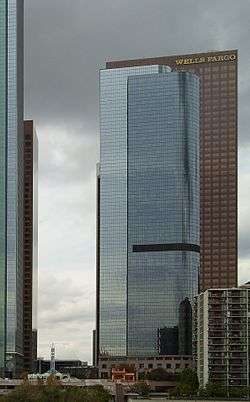One California Plaza
| One California Plaza | |
|---|---|
|
One California Plaza with the edge of Two California Plaza to the left | |
| General information | |
| Type | Commercial offices |
| Location |
300 South Grand Avenue Los Angeles, California |
| Coordinates | 34°03′08″N 118°15′05″W / 34.052230°N 118.251311°WCoordinates: 34°03′08″N 118°15′05″W / 34.052230°N 118.251311°W |
| Construction started | 1983 |
| Completed | 1985 |
| Owner | Beacon Capital Partners |
| Management | JLL |
| Height | |
| Roof | 176 m (577 ft) |
| Technical details | |
| Floor count | 42 |
| Floor area | 87,037 m2 (936,860 sq ft) |
| Lifts/elevators | 24 |
| Design and construction | |
| Architect | Arthur Erickson Architects |
| Developer | Metropolitan Structures West |
| Structural engineer | John A. Martin & Associates |
| Main contractor | The Beck Group |
| Website | |
| www.1calplaza.com | |
| References | |
| [1][2][3][4][5] | |
One California Plaza is a 176 m (577 ft) skyscraper located on the Bunker Hill District district of downtown Los Angeles, California. The tower is part of the California Plaza project, consists of two unique skyscrapers, One California Plaza and Two California Plaza. The Plaza also is home to the Los Angeles Museum of Contemporary Art, Colburn School of Performing Arts, the Los Angeles Omni Hotel and a 1.5-acre (0.61 ha) water court.[6]
Completed in 1985, One California Plaza has 991,836 sq ft (92,144.6 m2) of office space. The towers were designed by Arthur Erickson Architects and named BOMA Building of the Year in 1989.[6]
California Plaza was a ten year, $1.2 billion project. Started in 1983, the Two California Plaza tower was completed in 1992 during a significant slump in the downtown Los Angeles real estate market. The tower opened with only 30 percent of its space leased and overall vacancy rates in downtown office space neared 25 percent.[7] It was nearly 10 years before significant tall buildings were completed again in downtown Los Angeles.
California Plaza was originally planned to include 3 high rise tower office buildings instead of the two completed. Three California Plaza at 65 floors, was planned for a site just north of 4th St., directly across Olive St. from California Plaza's first two office highrises and was planned to house the Metropolitan Water District's permanent headquarters.[8]
The construction and $23 million cost of the MOCA Grand Avenue building was part of a city-brokered deal with the developer of the California Plaza redevelopment project, Bunker Hill Associates, who received the use of an 11-acre (4.5 ha), publicly owned parcel of land.[9][10]
See also
References
- ↑ "One California Plaza". CTBUH Skyscraper Database.
- ↑ One California Plaza at Emporis
- ↑ One California Plaza at Glass Steel and Stone
- ↑ "One California Plaza". SkyscraperPage.
- ↑ One California Plaza at Structurae
- 1 2 "One California Plaza". Maquire Properties. Retrieved 2008-12-26.
- ↑ Stevenson, Richard W. (November 11, 1991). "Office Glut Spreads in California". The New York Times. Retrieved 13 August 2010.
- ↑ Berton, Brad (April 26, 1993). "Los Angeles Community Redevelopment Agency's notice of default suit against Bunker Hill Associates". The Los Angeles Business Journal. Retrieved 13 August 2010.
- ↑ Rutten, Tim (December 6, 2008). "What MOCA really needs". Los Angeles Times.
- ↑ Hayes, Tome (May 12, 1985). "Los Angeles: For Downtown, An Ambitious Mixed-Use Project". The New York Times. Retrieved 13 August 2010.
Further reading
- Cameron, Robert (1990). Above Los Angeles. San Francisco: Cameron & Company. ISBN 978-0-918684-48-6.
